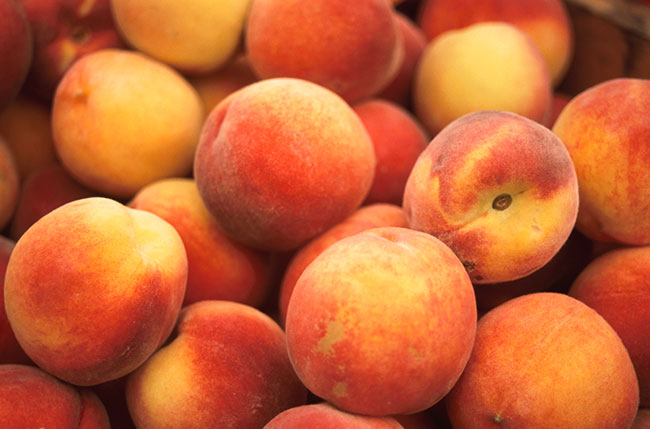
Peaches are highly regarded for their delectable flavor and smooth texture. Nectarines and peaches are typically classified separately, but they are different cultivars of the same species. The difference between the two is that peaches have fuzzy skin and nectarines are smooth. The genetic differences between peaches and nectarines can affect their flavor as well, hence the different classifications. The modern English word for peach comes to us from the French pêche which in turn derives from Latin malum persicum which meant “Persian apple.” This name was used because of the Roman belief that peaches originated in Persia. Research suggests that peaches in fact originated in northwest China, where the genetic diversity of peaches is the greatest. Peaches appeared in Chinese culture around 9000 BC; they appeared in the cultures of Japan, Korea, and much of the rest of Asia shortly thereafter. The peach tree, along with its blossoms and fruit were important in ancient Chinese, Japanese, and Korean folk medicine and religion. For instance, in Korea, peaches were believed to ward off spirits, both good and evil and peaches with double seeds were considered a good omen foretelling a mild winter. Peaches were introduced to Persia and to Europe via the Greeks by 300 BC. The Romans cultivated peaches as early as 100 BC. During the medieval and renaissance periods, peaches remained relatively common and they often appeared in works of art. Spanish explorers introduced the peach to the Americas in the 16th century. Peaches were fairly popular in the US, but commercial production of the fruit didn’t begin until the late 18th century.
A raw peach is a wonderful treat, but the fruit can be used in a multitude of ways. Due to their high pectin content and sweetness, peaches are great for jams, jellies and other preserves and as an ingredient for desserts such as pies, ice cream and, most notably, peach cobbler. Peach cobbler is a decadent dessert with sweet, warm flavors and a moist, yet crunchy texture. It is generally served with ice cream. Poaching peaches with honey is a sweet, easy dessert. For a more savory dish, try stewing chicken with fresh or preserved peaches.
When selecting peaches, look for ones that are free from obvious blemishes or breaks in the skin. A good peach will feel firm and heavy. While the fuzzy skin is perfectly edible, the fuzz can be a bit unpalatable. Thoroughly washing the peach will remove most of the fuzz. To remove the skin entirely blanche the peaches by boiling for one minutes then quickly transfer the peaches to ice water. Soak peaches only long enough to cool them. The skin should fall off the peach effortlessly. Like apples, the peach’s flesh will darken when exposed to air. To prevent this, coat the fruit in a small amount of citrus juice. Always wash fresh produce before use.


 BACK TO PRODUCTS
BACK TO PRODUCTS